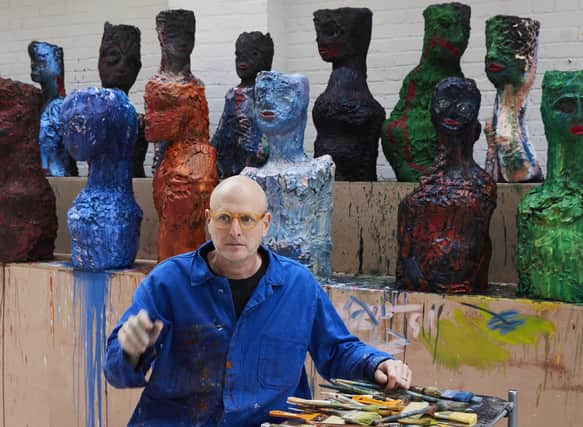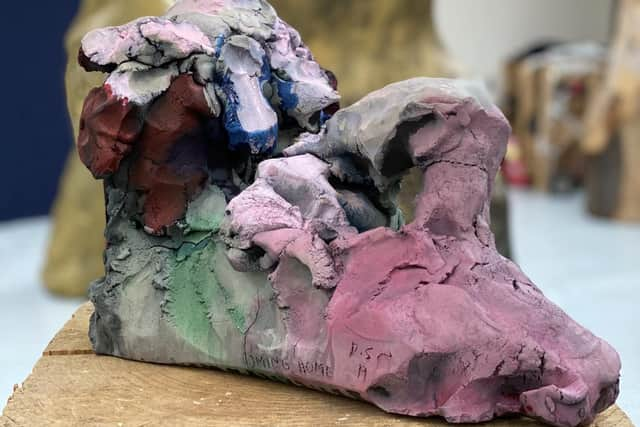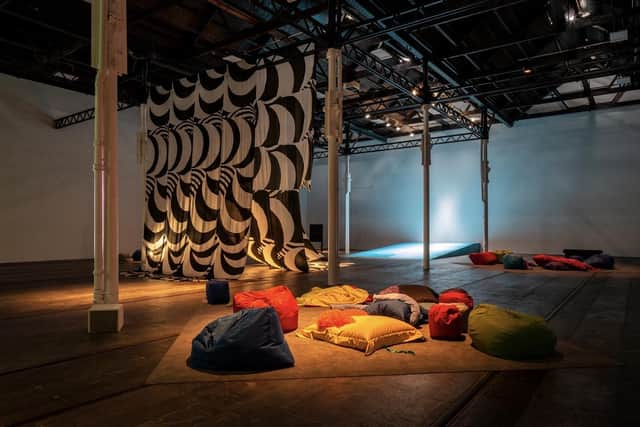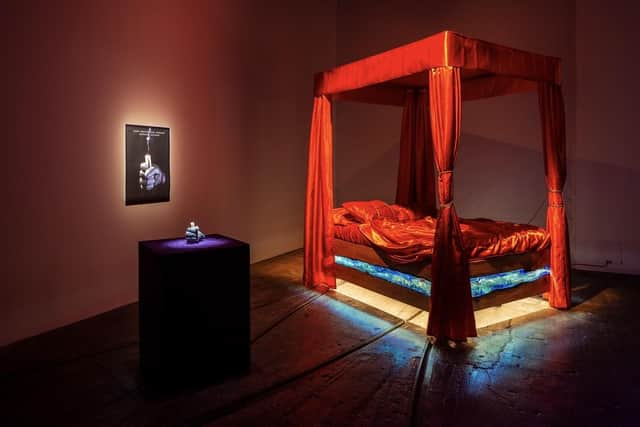Art reviews: Daniel Silver | Human Threads | Christelle Oyiri


Daniel Silver: Looking, Fruitmarket Gallery, Edinburgh ****
Human Threads, Tramway, Glasgow ****
Christelle Oyiri: Gentle Battle, Tramway, Glasgow ***
Walk into the lower gallery at the Fruitmarket in Edinburgh this summer and you immediately come face to face with The Audience, 18 life-size clay figures seated in two tiered rows. If the back row is somewhat distracted, whispering to each other or staring into space, the front row is looking directly at us. Looking at us, in fact, as we look at them.
They are people with attitudes and opinions; something about them suggests (to me, at least) that they’re more of an opera audience than a football crowd. Though roughly shaped and daubed brightly with thick oil paint, they are solemn, totemic forms, like gods in a temple who have got together for a gossip after hours. They set the tone for a show which is not passive: it requires some engagement from us.
Advertisement
Hide AdLondon-based Silver shifted to clay as his main medium just before the pandemic, having previously worked in marble, bronze, concrete and wood. Always more interested in imperfection than polish, he wanted a material which was more direct, tactile, spontaneous. Instead of working with assistants on complex processes which involved a lot of waste, he wanted to work alone with his own hands.
Then came lockdown, which must have consolidated this approach. The differences are clear, even in the first figures he made, Lover (pink) and Heart (orange): the flaws and cracks, the marks where his hands have gouged and shaped the clay, the combination of fragile and monumental. They seem to hold the potential for life in the way that a marble sculpture only mirrors life, like the Golem of Jewish mythology, the living man of clay.


There are three distinct “bodies” of work in this show. Downstairs, The Audience, and the earliest figures, are shown with a series of drawings made in Death Valley, California, strongly coloured works with a sculptural quality and a clear relationship to the modernism of artists such as Picasso.
Upstairs, a series of smaller figures are displayed on glass tables with thick, hand-moulded clay legs and feet; Silver says they remind him of a camel train crossing the desert. These figures were made when working with dancers and, while clearly solid and heavy-footed, they nevertheless evoke movement. Look at one for a while and it might suddenly snap into focus, communicating the essence of a movement, like the cowboy who appears to be line-dancing, or the woman kneeling, stretching her arm behind her head.
In the warehouse space, the totems have lost the figurative elements of faces and limbs, but there is still something of the human which lingers in the scale and the way they relate to one another. Like all the works in this show, they are stronger as a group than individually, and take time to reveal themselves to us. However, in exchange for a little time and imagination, they provide an intriguing encounter with the mostly human.
Human Traces is the title of the exhibition currently at Tramway created by Edinburgh-based charity Artlink, drawing on long-term engagement with people with profound and multiple learning disabilities. Half a dozen artists have made multi-sensory pieces informed by this work, creating an environment which curators Alison Stirling and Nicola White describe as a “gentle fairground”.


Advertisement
Hide AdIt is a place of soft sounds – a snatch of music, a bell ringing – and sensations: a long curtain (designed by Laura Spring and Claire Barclay) billowing in the breeze from a fan; an impressive tower by Adam Putnam putting out smoke and, occasionally, bubbles. There are coloured lights, and carpeted areas covered in bean bags and cushions. Though the show never wholly transforms the big hard box which is Tramway 2, it’s quietly intriguing. You want to explore.
Children know exactly what to do. They run and plunge into the beanbangs, lie down on Wendy Jacob’s blue ramp, which transmits vibrations and sounds. They peer into Matthew Ronay’s black boxes – like miniature theatres – to watch moving shapes and colours and, at one of the booths, breathe in a sweet, heady perfume.
Advertisement
Hide AdThe thing which looks most like a conventional piece of art is a projection by Laura Aldridge and Lauren Gault, beaming light through a slowly turning perspex disc full of colours and shapes, and enlarging it through a bell jar of water to create a gently mesmerising abstract film. But this isn’t an exhibition in the conventional sense to be processed, or analysed, or figured out – maybe not reviewed either. It’s to be experienced, and perhaps in so doing one creates a fragile bridge to those whose disabilities make their experience of life very different to our own.
From a gentle fairground to a Gentle Battle, in Tramway 5, the first solo exhibition by Christelle Oyiri, an artist and DJ based in Paris whose heritage is in Ivory Coast and Guadeloupe. Her work is informed by issues of colonialism, particularly in relation to Ivory Coast, which has been independent from France since 1960 but without full sovereignty, and has experienced civil war and unrest in the last two decades.


There are a lot of works saying a lot of things in a comparatively small space: images of Ivorian tribal masks which are now in Western museums, etched on to backlit mirrors; a giant model of an elephant tusk, copied from one found on the wreck of a slave ship; a spectacular four-poster bed draped in red silk, a warrior’s resting place which offers no rest; fake currency scattered on the floor.
Not surprisingly, music plays an important part. Central to the show physically, and perhaps also in terms of ideas, is a three-part film paying tribute to Douk Saga, the Ivorian creator of coupé decalé music, a style born in the midst of political crisis despite its relentless cheerfulness. A second film explores Logobi, a Ivorian folk dance which became, in the late noughties, a craze among the teenagers of Paris’ working-class suburbs.
This barrage of ideas, stories and themes never quite resolves into a coherent show, and some of the individual pieces struggle to communicate visually what the artist does in her comprehensive text. But there is no mistaking the energy, creativity or anger. This gentle battle isn’t really very gentle at all.
Daniel Silver runs until 25 September; Human Traces until 28 August; Christelle Oyiri until 14 August